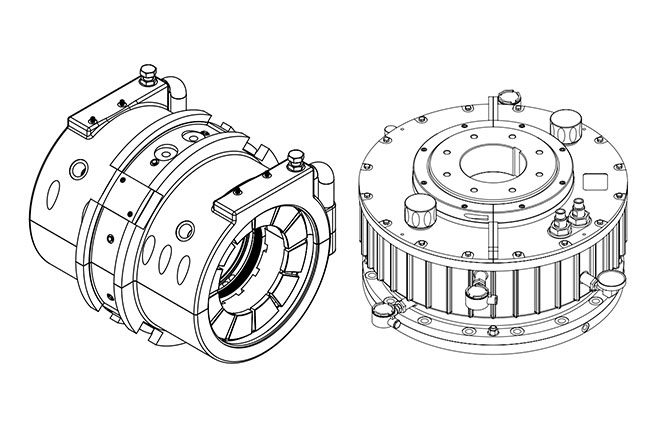Will bearings of appropriate size and material be able to withstand the radial loads generated by the impeller?
In
pump bearing design, it is necessary to ensure that the bearing can withstand the radial load from the pump impeller. A common method is to select a bearing of appropriate size and material to ensure that it can withstand the radial force generated by the impeller.
Determining the radial force generated by the pump impeller is a primary design task. Radial force refers to the force perpendicular to the axial direction, which is caused by the centrifugal force generated by the rotation of the pump impeller. The size of this force is related to the size of the impeller, the rotation speed and the properties of the working fluid. By performing fluid dynamics analysis and impeller design during the pump design process, the magnitude and direction of the radial force can be determined.
Based on the determined radial force, the next step is to select the appropriately sized bearing. The size of the bearing should be large enough to withstand the radial force generated by the impeller to avoid bearing wear, damage or failure due to excessive load. The selection of bearing size needs to consider factors such as impeller size, rotation speed, centrifugal force and working conditions. Usually, the most suitable bearing size can be determined through the bearing manual or related software.
In addition to size, the material of the bearing is also one of the key factors to ensure that it can withstand radial loads. Common bearing materials include metals, ceramics, and plastics. Metal bearings usually have high strength and rigidity and are suitable for carrying high loads. Ceramic bearings have high wear resistance and corrosion resistance and are suitable for special working conditions. Plastic shafts have lower density and better self-lubricating properties, making them suitable for applications with light loads and low friction requirements. Choosing the right bearing material can improve the load-bearing capacity and life of the bearing.
In addition, in the design of pump bearings, bearing assembly and lubrication should also be considered. Reasonable assembly can ensure the normal operation of the bearing and avoid uneven or excessive loads due to improper installation. Lubrication is the key to reducing friction and wear. Choosing appropriate lubrication methods and materials can improve the working efficiency and life of the bearing.
In pump bearing design, selecting bearings of appropriate size and material is an important way to ensure that they can withstand the radial loads generated by the impeller. By determining the size and direction of the radial force, selecting the appropriate bearing size and material, as well as reasonable assembly and lubrication, the reliability and durability of the bearing in pump operation can be ensured.
Regularly monitoring the temperature and vibration of pump bearings can help us discover what is happening with the bearings in time?
Regularly monitoring the temperature and vibration of
pump bearings is an effective preventive maintenance measure that can help us promptly detect bearing failures or insufficient lubrication and prevent further deterioration of the failure. In actual operation, regular monitoring of the temperature and vibration of pump bearings can be understood as a routine detection method, similar to a health check-up. This article will elaborate on the problems and causes that may be indicated by abnormally high or high temperatures, as well as the corresponding maintenance and adjustment measures, from two aspects: temperature and vibration.
Abnormally high temperatures may indicate bearing failure or insufficient lubrication. Pump bearings generate heat during normal operation. Excessive temperatures may be caused by bearing wear, insufficient lubrication, or grease aging. If the bearing temperature exceeds the set safety range, it may cause serious problems such as premature bearing wear, lubricant failure, and even fire. Therefore, when the temperature is abnormally high, the bearings should be maintained and adjusted in time. First, you need to check the lubrication of the bearing to ensure that the amount of lubricant is sufficient; second, you can check whether the bearing is blocked, worn, damaged, etc., and replace the bearing in time if necessary. In addition, the operation of the pump should be checked to ensure that the pump is running smoothly and the load is reasonable to avoid excessive temperatures.
Greater vibration may indicate bearing failure or insufficient lubrication. The pump bearings will produce a certain amount of vibration during operation, but if the vibration is too large, it may cause problems such as premature wear and breakage of the bearings. There may be many reasons for excessive vibration, such as uneven bearing wear, poor installation, foreign matter entering the bearing, etc. When the vibration is found to be large, the bearings need to be maintained and adjusted. First, you need to check whether the bearings are worn or damaged, and replace the bearings in time if necessary; secondly, you can check whether the bearings are installed correctly and whether there are problems such as looseness, and make corresponding adjustments if necessary.
During the maintenance and adjustment process, operators need to have certain professional knowledge and skills to ensure the safety and effectiveness of the maintenance process. In addition, for some large or complex pump systems, it may be necessary to use advanced monitoring equipment to monitor temperature and vibration in real time to more accurately judge the condition of the bearings.
Regularly monitoring the temperature and vibration of pump bearings can help us detect bearing failures or insufficient lubrication in time, thereby avoiding failures and extending the service life of the bearings. If the temperature is abnormally high or the vibration is large, timely maintenance and adjustment are required to ensure the normal operation of the pump bearings. At the same time, operators should have relevant knowledge and skills to ensure the safety and effectiveness of maintenance work. Finally, for some large or complex pump systems, you can consider using advanced monitoring equipment for real-time monitoring to more accurately judge the operating status of the bearings.
